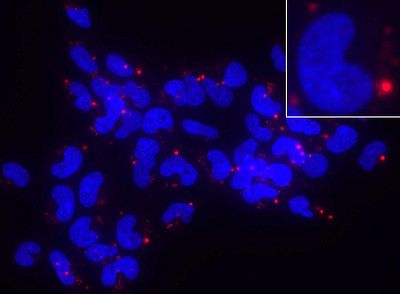05/07/2023
Print PageRNA rings thought to contribute to the development of cancer in children

What was the research question or scientific inquiry behind your study?
Neuroblastoma is a solid cancer that occurs in early childhood. Especially high-risk cases are unfortunately associated with a limited prognosis. Unlike adult cancers, which are often characterized by multiple changes in DNA, such as mutations, that can explain the development of a cancer, neuroblastoma harbors very few such changes. In our study we instead investigated whether ring-shaped RNAs (circRNAs) might play a role in neuroblastoma. These are regulatory RNA molecules that are known to control gene function and are therefore important for tumor growth.
How did you approach the topic?
We analyzed tumor samples of more than 100 neuroblastoma patients using high-throughput sequencing, which allowed us to analyze all RNAs of a tumor at the same time. We compared these with samples of other tumors and healthy controls, to identify those RNAs that are present on a higher level in neuroblastoma and might thus be beneficial for the tumor. We then used cultivated cells in the laboratory to understand how exactly these RNAs can contribute to the growth and survival of a tumor cell.
What did you discover?
Very aggressive neuroblastomas often harbor several copies of the MYCN gene, a known driver of neuroblastoma. We could show that those tumors have lower levels of RNA rings. Our data, also from another childhood cancer, medulloblastoma, suggest that MYCN appears to globally suppress the formation of RNA rings. However, we also identified a group of RNA rings that are highly produced in neuroblastoma. One of these RNA rings enhances the growth and survival of neuroblastoma cells.
Was there anything that surprised you?
It was surprising to us that MYCN suppressed the formation of RNA rings, since MYCN generally tends to augment the production of RNAs. We were however able to clarify that the inhibition of RNA ring formation apparently occurs via a detour, i.e. the regulation of a protein.
What’s your takeaway?
Our study adds to the general understanding of the origins of neuroblastoma and highlights the importance of regulatory RNAs. The RNA rings that are upregulated in neuroblastoma may open up a new therapeutic angle for targeted RNA therapies. Therefore, we will now go in search of the most promising candidates. We also want to develop a method that allows us to infer from the RNA rings in the blood of neuroblastoma patients whether they might suffer from a relapse of disease and would need a modification of their therapy.